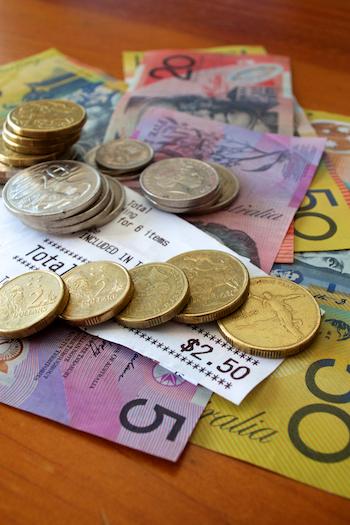How much is that?
Duration/age

When you are out shopping with your child talk about the cost of items, explaining that you need to pay for them before you can take it home.
Talk to your child about the different ways that you can pay for something. You might pay using cash or by EFTPOS or credit card. Talk about why you have chosen to pay that way. Explain that if you pay by cash there might be change that could be a mixture of notes and coins.
I am going to pay cash for the pie because I have enough money in my purse.
The shoes are a lot of money. I am going to pay by card as I don’t like to carry around that much money.
As you walk around, talk about the cost of different items, comparing them to each other.
If we buy the 10kg bag of flour it is cheaper than the smaller 2kg bag. It works out to be $1 a kilo compared to $2 a kilo.
If you are going to pay using cash explore the different ways that you can combine notes and coins to make the total. Talk about whether the purchase is a large amount or a small amount.
The pie is only $3 so I am going to use 1 and 2 dollar coins to pay. If I buy the pie, chips and a drink it is more than $10 so I will need to pay with a 10 and a 5 dollar note.
Materials you will need
- Money
Alternative tools
- Credit card
- Chequebook
- EFTPOS
Skills this activity improves
Why does this matter?
When children help with shopping and paying for goods they are exploring measurement and using number to measure, compare and make decisions.
What does this lead to?
When children help with doing the shopping they are developing an understanding that money is an amount or a number and that they can use number to quantify their world and make decisions.
Language to use
- Cheap, expensive, cost
- Cash, cheque, credit card, lay-by
- Save, bank, credit
- Compare
- Small, large
Questions to use
- How much is that?
- Does that cost more or less?
- Do we have enough money to pay for that?
- How will we pay for that?
Useful tips
- Money is a very tricky concept for children to grasp, as it is so abstract. Try to talk about the real cost of something rather than a made-up amount.
- Use real examples when comparing the cost of an object, such as ‘an apple costs less than a car'.
- You might also like to take a look at the Exploring junk mail activity.
- Remember to talk to your child in your home language.
More ideas
- Set up a play shop at home.
- Explore the junk mail together. Talk about the different cost of each item.
- If your child has their own money and wants to buy something, use the junk mail to look at the cost of what they want. Talk about how much they will need compared to the amount they have
Variation by age
Three to five year olds
- Use the junk mail to create a shopping list. Try and find the cheapest place for apples or bananas using the junk mail.
- Make a wish list with your child of what they want to buy. Find out how much the items cost and encourage them to save the money.
Questions to ask
- How much money do you have?
- What do you want to buy?
- Which shop is cheaper?
Language to use
- More, less, the same
- Cost, price, amount
- Save
- Cheapest, expensive


